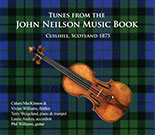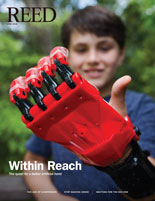
IRIS login | Reed College home Volume 95, No. 2: June 2016
Reediana Briefs

Tunes from the John Neilson Music Book, by Vivian Tomlinson Williams ’59 and Philip L. Williams ’58 (Voyager Recordings & Publications, 2016). In 1981 a 100-year-old handwritten manuscript of Scottish dance tunes, which had made its way to Arcata, California, was discovered by Vivian, who later edited and published the manuscript, which is known as The John Neilson Music Book. Now, with well-known Seattle dance musicians and her husband Phil, she has recorded a sampling of its reels, polkas, waltzes, hornpipes, and jigs. Vivian is an internationally known traditional fiddle player and offers, in this recording, a fascinating glimpse into the dance music of the Victorian era in Scotland.

Ballet Noir, by Caroline Miller ’59 (Black Rose Writing, 2016). In a tale of death, intrigue, and paranormal romance, Tara Bentley, a young prima ballerina, travels to Europe for her first tour. Her excitement turns to horror when she’s haunted by the voice of her deceased dance teacher, Yelena Natilova. Tara fears she might be going mad until she meets a necromancer who assures her the voice is real.
The Seeker Is the Sought, by Marvin Richard Montney ’61 (Outskirts Press 2011). In his latest poetry collection, Marvin explores the nature and transformative power of love. Divided into three sections—“The Seeker,” “The Sought,” and “The Found”—the poems are interesting not only in their philosophic examinations, but also in their fresh language and lyricism.
Sanfilippo Syndrome, by Linera Lucas ’71 (Change Seven Magazine, Spring 2016). An adolescent girl, Terese, suffers from an inherited genetic disorder called Sanfilippo disorder. She and her family brace themselves for the behavioral and physical changes that the disorder is known to cause, but cannot fully anticipate the disastrous consequences of the disease.
Dreamer’s Run, by Thomas Owen ’73 (2016). On a hostile planet without a name, the last human outpost is about to be destroyed. The only hope is if Merrill, the head of security, can catch a saboteur and make him talk, but the answers and reasons may not be what Merrill wants to hear. Thomas is the author of Sherlock Holmes and the Adventure of the Modern Cinderella, and ,most recently, The Fortunes of Olaf Shorthand.

Irish Nationalists in America: The Politics of Exile, 1798–1998, by David Brundage ’73 (Oxford University Press, 2016). The first full-scale history of Irish nationalists in the United States, this book offers insight into the experience of one of America’s largest immigrant groups and the phenomenon of diasporic or “long-distance” nationalism. Beginning with the brief exile of Theobald Wolfe Tone, founder of Irish republican nationalism, in Philadelphia on the eve of the bloody 1798 Irish rebellion, and concluding with the role of Bill Clinton’s White House in the historic 1998 Good Friday Agreement in Northern Ireland, the book tells a story of more than two hundred years of Irish American (and American) activism in the cause of Ireland.
Biblical Time out of Mind: Myths, Maps, and Memories, by James Freeman ’78 and Tom Gage (Cune, 2016). The authors argue that neither Moses nor the Hebrews were in Egypt until around 1000 BCE. They sift through research of a Hyksos evacuation of Egypt which was led by an Eastern leader 500 years before Moses, asking whether the Exodus of scripture was actually a Hebrew exodus.

Two Percent Solutions for the Planet, by Courtney White ’82 (Chelsea Green Publishing, 2015). The premise of this pragmatic primer on regenerative practices in food and land use is that small changes make big differences. Two percent is “an illustrative number—not a scientific one—meant to stimulate our imaginations” about how small changes can have dramatic impact. A follow-up to Grass, Soil, Hope: A Journey through Carbon Country, in which Courtney argues for carbon sequestration through land management, Two Percent Solutions profiles a variety of nature-based approaches to global problems. Approaches include restoring the carbon cycle with cattle, no-till farming, agrivoltism, micro-sizing, “growing topsoil,” and a bottom-up approach to species and habitat restoration.

Virtual Billions, by Eric Geissinger ’91 (Prometheus Books, 2016). Eric investigates Bitcoin’s historical roots, charts its unprecedented rise, and delves into the curious stories of those involved in its invention, growth, and popularization: Satoshi, the elusive creator of Bitcoin; Ross Ulbricht, known as the Dread Pirate Roberts, who created and ran the largest and most successful dark web drug market using Bitcoin; and the Winklevoss twins, Harvard graduates, Olympic rowers, famous Facebook litigants, and Bitcoin entrepreneurs who own one percent of all bitcoins in existence.

Farewell to the God of Plague: Chairman Mao’s Campaign to Deworm China, by Miriam Gross ’91 (UC Press, 2016). Chairman Mao’s crusade against snail fever, a devastating parasitic disease, was immortalized in his 1958 poem “Farewell to the God of Plague,” and stands as one of the most famous public health campaigns in the history of the People’s Republic of China. “Its reputation is so compelling, its methods are still used in China, most recently in the campaign against SARS,” Miriam writes. But, using newly available archives, Miriam documents a grassroots resistance and shows that Mao’s campaign triumphed, not because of its touted mass-prevention efforts, but from its unacknowledged treatment arm, carried out jointly by banished urban doctors and rural educated youth.
Diamonds at Dusk, by Catalina Claussen ’93 (Progressive Rising Phoenix Press, 2016). Cassie is hard to miss: she’s the one in cowgirl boots who, up until this morning, wasn’t interested in boys. But on the eve of her sixteenth birthday something inside her knocks loose. His name is Chadwick Dean Holbrook, a college prep school boy from Albuquerque and Cassie’s long-time “fair weather” friend. A broken promise, jealousy, and a charming misfit named Maverick Britton threaten to draw Cassie into a perilous world in this Southwestern YA novel.
The Crimes of Sept. 10, 2001, by Robert Kahn ’73 (Black Rose Writing). In the third novel in Robert’s USA Trilogy 2015 (see also The Back Page and Killing the Sniper), the best friend of the world’s first great internet criminal, Erasmus Korb, wonders whether his friend was just lucky, or was it something else? The FBI wants to know too. Robert is still an editor for Courthouse News, founded and published by Bill Girdner ’72.

Hell, recorded by Kip Berman ’03 (Painbow, 2015). After positive feedback to a demo version of the track “Hell,” Kip and his band, The Pains of Being Pure at Heart, recorded and released an EP featuring the title track and two others. The title track is an upbeat indie-pop song with a lush sound. The two cover songs which follow flaunt the band’s mastery of their alternative rock influences: “Felt” by Ballad of the Band, and a version of James’s “Laid” that hews closely to the original, with with crisp female vocals by Jen Goma.

The Arab Revolts, by Amanda Ufheil-Somers ’08 (Indiana University Press, 2013). The 2011 eruptions of popular discontent across the Arab world, popularly dubbed the Arab Spring, were local manifestations of a regional mass movement for democracy, freedom, and human dignity. Authoritarian regimes were either overthrown or put on notice that the old ways of oppressing their subjects would no longer be tolerated. These essays cover events in Tunisia, Egypt, Bahrain, Syria, and Yemen. Written for a broad audience of students, policymakers, media analysts, and general readers, the collection reveals the underlying causes of the revolts by identifying key trends during the last two decades leading up to the recent insurrections.

Golden House, music video directed by Roland Dahwen Wu ’13 (Pink Smoke Records, 2015). A gorgeous music video for the song “Golden House” for the band Tiburones, featuring Nick Delffs and Luz Elena Mendoza, moves between shots of sumptuous landscapes and artfully shadowed profiles of the musicians. The feel is of being on a road trip out West, driving perpetually through golden hours, listening to music that enhances the rugged scenery, and scenery that enhances the exquisite music.
The Pictorial Maps of Fred A. Routledge, by Prof. Craig Clinton [theatre 1978–2010](Oregon Historical Quarterly, Spring 2016). Before air travel and satellites could provide pictures of Earth seen from distant vantage points, “it was the interpretive skills of artists that enabled such vision,” Craig writes. One such artist was Fred A. Routledge, whose work was instrumental in bringing new citizens to the Pacific Northwest. In an article rich with colorful examples of Routledge’s work, Craig traces the cartographer’s career from his street-level illustrations to his stunning bird’s-eye regional views.

LATEST COMMENTS
steve-jobs-1976 I knew Steve Jobs when he was on the second floor of Quincy. (Fall...
Utnapishtim - 2 weeks ago
Prof. Mason Drukman [political science 1964–70] This is gold, pure gold. God bless, Prof. Drukman.
puredog - 1 month ago
virginia-davis-1965 Such a good friend & compatriot in the day of Satyricon...
czarchasm - 4 months ago
John Peara Baba 1990 John died of a broken heart from losing his mom and then his...
kodachrome - 7 months ago
Carol Sawyer 1962 Who wrote this obit? I'm writing something about Carol Sawyer...
MsLaurie Pepper - 8 months ago
William W. Wissman MAT 1969 ...and THREE sisters. Sabra, the oldest, Mary, the middle, and...
riclf - 10 months ago